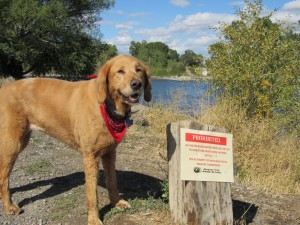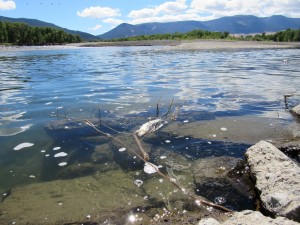
The recent and ongoing mortality of thousands of mountain whitefish, along with trout, and other fish and closure of nearly 180-mile stretch of the upper Yellowstone River is another clarion call to Montanans to turn our attention to the health of our state’s longest undammed river. Scuttlebutt in downtown Livingston nearly two weeks ago caught anglers’ attention as many blamed summer heat and low flows in the river as the likely cause. Now rainbow and Yellowstone cutthroats are dying too. Montana Fish, Wildlife & Parks has confirmed that high water temperatures and low flows drive “fish kills” through a parasite-caused kidney disease that has been known to be a killer of salmonid fishes (salmon, trout, and whitefish) for decades, but not in Montana. What is unknown is when the die-offs will stop, how many fish will be affected, how big an area will be involved, and whether the parasite will be transported to other streams that may suffer a similar outbreak.
While those who flock to the Yellowstone each year to fish may track the situation closely for a while, those who live and work with the river all year long have a more abiding concern borne on the winds of change, a change that none of us remember having seen before. Could the dying fish be victims of what local meteorologists now call “local climate situations” causing lower snowpack and early runoff? It seems clear that the supply of surface water in the upper Yellowstone is too little during hot weather to supply human needs, and keep our prized cold water river system healthy. What can we do to keep this from happening?
Some of the answers can be found in the 2015 Yellowstone River Cumulative Effects Analysis (CEA), which reports the results of a nearly twenty-year research effort coordinated by the Yellowstone River Conservation District Council (YRCDC) with funding from the Army Corps of Engineers. Authors of the CEA included county conservation districts, conservation agencies and nonprofits, land trusts, and concerned Montanans. The CEA report recommended a number of practices, which hold hope for conserving the river. One recommendation was to create Channel Migration Easements (CME) to protect the Yellowstone’s ability to migrate across the floodplain. Floodplains perform vital functions, including recharging groundwater, filtering sediments and pollutants, and reinvigorating critical habitats that sustain the area’s fish and wildlife populations. CMEs protect floodplains and their natural functions and provide an incentive to landowners.
On February 11, 2016, the Montana Fish & Wildlife Commission approved the purchse of the first Channel Migration Easement (CME).
CMEs are a special kind of conservation easement where, in exchange for a payment, the landowner voluntarily gives up the right in  perpetuity to riprap or build dikes and levees on the banks of the Yellowstone that would prevent the river from flowing onto the floodplain. Funds to purchase the first CME originated not from taxpayers or anglers, but from the interagency Upper Basin Pallid Sturgeon Working Group and the Western Area Power Administration who oversee habitat conservation as part of the Pallid Sturgeon Recovery Program in the lower Yellowstone. However, CMEs are equally important to the upper Yellowstone where trout populations are an important foundation of Montana’s economy. The thousands of mountain whitefish, along with trout and other fish found dead in the river are of great concern to Montanans not just because of their recreational value but how their loss might impact the health of Montana’s economy and river ecology in the long term. Trout anglers might wonder what they can do, in addition to buying their fishing license or giving to conservation groups who have funded projects in the Yellowstone to restore spawning areas, maintain instream flows, increase irrigation efficiency, and other measures. Surely there must be more that can be done?
perpetuity to riprap or build dikes and levees on the banks of the Yellowstone that would prevent the river from flowing onto the floodplain. Funds to purchase the first CME originated not from taxpayers or anglers, but from the interagency Upper Basin Pallid Sturgeon Working Group and the Western Area Power Administration who oversee habitat conservation as part of the Pallid Sturgeon Recovery Program in the lower Yellowstone. However, CMEs are equally important to the upper Yellowstone where trout populations are an important foundation of Montana’s economy. The thousands of mountain whitefish, along with trout and other fish found dead in the river are of great concern to Montanans not just because of their recreational value but how their loss might impact the health of Montana’s economy and river ecology in the long term. Trout anglers might wonder what they can do, in addition to buying their fishing license or giving to conservation groups who have funded projects in the Yellowstone to restore spawning areas, maintain instream flows, increase irrigation efficiency, and other measures. Surely there must be more that can be done?
Channel migration easements, strung together like a string of pearls up and down the river from North Dakota to Yellowstone National Park will help preserve the river and build resiliency to drought and other catastrophes. Funding for CMEs can come from many sources but they’re not cheap. Montana Aquatic Resources Services (MARS), a now four-year-old conservation nonprofit operating in Bozeman, has been identifying potential projects and raising funds to purchase CMEs. Montana’s leading private land trusts, The Nature Conservancy and Montana Land Reliance, work with Yellowstone River landowners to create the easements and to steward them in perpetuity. MARS has identified 61 Yellowstone River bends as priority CME areas to date. Landowner participation is strictly voluntary. Primary interest to date has come in the middle and lower Yellowstone where channel movement and the damage it can cause to riverside properties is all too familiar to agricultural producers. The easements, while conserving traditional agricultural practices, prohibit removal of the river’s forests, riprapping the river’s banks, dumping of materials along the river banks.
CMEs aren’t a silver bullet. But the program, the first of its kind in the nation, is a big step in the right direction to conserving a river of the Yellowstone’s size.
 The MARS Yellowstone River CME Program is funded by several sources including charitable donations from Montanans and others to conserve our nation’s headwaters. More funding is needed now and for the future. How many CMEs do we need to conserve the Yellowstone? MARS answer is simply, the River is the valley’s lifeline. As such its value to agriculture, to recreation, to the quality of life of Montanans is nearly limitless. MARS knows that the first CME was the most important, as it paved the way for the second which will also close in 2016. Others are under development. Funds must be raised. Awareness must be too. People, Montanans and others, need to know that the river needs many people to invest in CMEs and other conservation strategies in the Yellowstone to keep the river and floodplain alive, cold, clean and healthy. Whitefish in Park County today are proof that much more is needed.
The MARS Yellowstone River CME Program is funded by several sources including charitable donations from Montanans and others to conserve our nation’s headwaters. More funding is needed now and for the future. How many CMEs do we need to conserve the Yellowstone? MARS answer is simply, the River is the valley’s lifeline. As such its value to agriculture, to recreation, to the quality of life of Montanans is nearly limitless. MARS knows that the first CME was the most important, as it paved the way for the second which will also close in 2016. Others are under development. Funds must be raised. Awareness must be too. People, Montanans and others, need to know that the river needs many people to invest in CMEs and other conservation strategies in the Yellowstone to keep the river and floodplain alive, cold, clean and healthy. Whitefish in Park County today are proof that much more is needed.
Yellowstone River farmers and ranchers, long on the land, know that they live and work with a sleeping tiger. When the tiger awakens during its high flow periods, it’s best to be well out of reach and to stand away as the river mingles with its forests, islands, wetlands, and streamside pastures. It builds character in itself and its streamside owners, sometimes with frightening speed and typically mind-bending energy. It’s the hope of MARS and our many project partners that soon, the Yellowstone CMEs will be a place where the river moves as it always has and the fisheries within its bank are healthy and resilient in our unpredictable future.
Tom Hinz, Program Development Director, Montana Aquatic Resources Services
Tom Hinz was instrumental in developing and coordinating Montana’s first In-Lieu Fee program in 2004. Throughout his career, he has worked for the National Park Service, consulted for the U.S. Department of Interior, and spent over 42 years of his life protecting wildlife and migratory birds for the US Fish and Wildlife Service. When he is not out actively fighting to protect Montana’s precious rivers and streams, he enjoys time with his wife Candy and cat Ozzie on their beautiful Gallatin River property.
